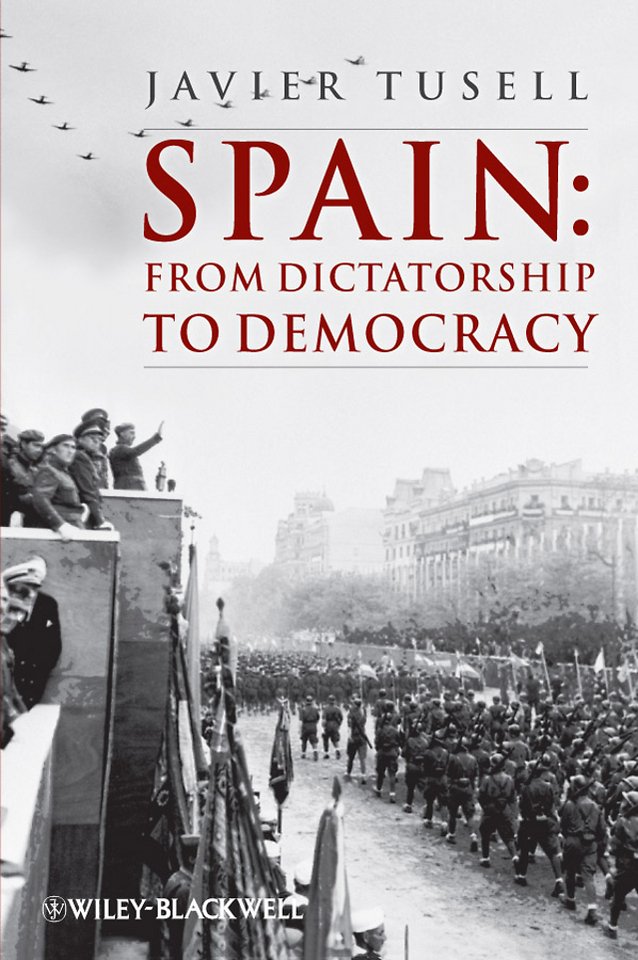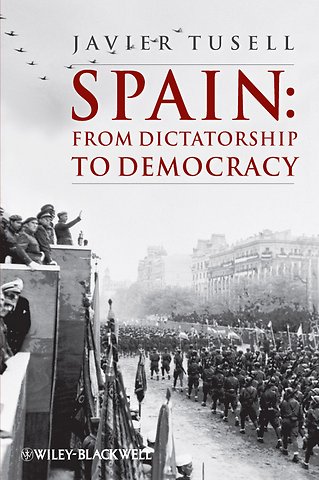Spain – From Dictatorship to Democracy
From Dictatorship to Democracy
Samenvatting
This comprehensive survey of Spain s history looks at the major political, social, and economic changes that took place from the end of the Civil War to the beginning of the twenty–first century.
A thorough introduction to post–Civil War Spain, from its development under Franco and subsequent transition to democracy up to the present day
Tusell was a celebrated public figure and historian. During his lifetime he negotiated the return to Spain of Picasso s Guernica, was elected UCD councillor for Madrid, and became a respected media commentator before his untimely death in 2005
Includes a biography and political assessment of Francisco Franco
Covers a number of pertinent topics, including fascism, isolationism, political opposition, economic development, decolonization, terrorism, foreign policy, and democracy
Provides a context for understanding the continuing tensions between democracy and terrorism, including the effects of the 2004 Madrid Bombings
Specificaties
Inhoudsopgave
<p>Introduction.</p>
<p>Franco: Biography and Political Practice.</p>
<p>Francoism: A Form of Dictatorship.</p>
<p>Victors and Vanquished: The Disasters of the Civil War and Repression.</p>
<p>Exile and the Start of the Postwar Period in Spain.</p>
<p>Bibliography.</p>
<p>Notes.</p>
<p>1. The Temptation of Fascism and the Will to Survive (1939 51).</p>
<p>A Failed Attempt to Make Spain Fascist.</p>
<p>The Temptation to Intervene and Internal Conflict (1940 2).</p>
<p>Stumbling Progress towards Neutrality (1942 5).</p>
<p>Cosmetic Change: Regime Politics between 1945 and 1951.</p>
<p>Opposition from Survivors: The Spanish Left from 1939 to 1951.</p>
<p>The Monarchist Alternative.</p>
<p>Franco in Isolation.</p>
<p>The Dark Night : Autarchy and Rationing in the 1940s.</p>
<p>Culture: Penance and Survival.</p>
<p>Bibliography.</p>
<p>Notes.</p>
<p>2. The Years Of Consensus: The High Point of the Regime (1951 65).</p>
<p>The End of International Isolation: The Concordat and Pacts with the United States.</p>
<p>Spain and Europe: Colonization of Morocco Ends.</p>
<p>The Regime and the Opposition up to 1956.</p>
<p>A New Political Opposition.</p>
<p>For or against Falange: Political Life under the Regime between 1956 and 1965.</p>
<p>The Easing of Autarchy and the Change in Economic Policy.</p>
<p>From Political Opposition to Social Opposition.</p>
<p>Culture in the Francoist Middle Period: The End of the Penitential Years.</p>
<p>Daily Life and Leisure Activities.</p>
<p>Bibliography.</p>
<p>Notes.</p>
<p>3. Economic Development, Apertura, and the Late Franco Years (1966 75).</p>
<p>Economic Development in the 1960s and 1970s.</p>
<p>The Modernization of Spanish Society.</p>
<p>The Change in Spanish Catholicism.</p>
<p>Apertura (1965 9).</p>
<p>The Succession. Matesa and Internal Splits in the Regime.</p>
<p>Worker Protest. Terrorism.</p>
<p>The Late Franco Period: Carrero Blanco as President.</p>
<p>Late Francoism: Arias Navarro s Government.</p>
<p>Opposition Activity: The Road to Unity.</p>
<p>Spain and the Western World.</p>
<p>Late Decolonization: Guinea and the Sahara.</p>
<p>A Politically Committed Culture?.</p>
<p>Spain at the Time of Franco s Death.</p>
<p>Bibliography.</p>
<p>4. The Transition to Democracy (1975 82).</p>
<p>The Monarchy: King Juan Carlos I.</p>
<p>The Death–throes of the Past.</p>
<p>Adolfo Suárez: The Road from Liberalization to Democracy.</p>
<p>Facing Difficulties: Terrorism and the Military Coup.</p>
<p>Parties and Elections.</p>
<p>The Long Road towards a Constitution.</p>
<p>An Unresolved Issue: Nationalism and Terrorism.</p>
<p>The Triumph and Fall of Adolfo Suárez.</p>
<p>The Army and the Transition: February 23.</p>
<p>Calvo Sotelo s Government and the Crisis in Center Politics.</p>
<p>Foreign Policy.</p>
<p>Economic Policy and Social Change.</p>
<p>October 1982: The End of the Transition.</p>
<p>Bibliography.</p>
<p>5. Consolidating Democracy: The Socialist Government (1982 96).</p>
<p>Felipe González and the Two Souls of Spanish Socialism.</p>
<p>The Socialists First Term in Office. Reform of the Armed Services, an Economic Update and Foreign Policy.</p>
<p>A Means of Consolidating Democracy. The GAL.</p>
<p>Elections and Public Opinion in the Second Half of the 1980s.</p>
<p>The Second Term in Office: Social Policies and Union Protests. Spain and the World.</p>
<p>Policy on the Autonomous Communities: A New Vertebrate Structure for the Spanish State.</p>
<p>The Loss of an Absolute Majority.</p>
<p>A Tense Term of Office (1993 6).</p>
<p>The 1996 General Election. Drawing up the Balance on the Socialists Time in Government.</p>
<p>Culture in the Post–Franco Period.</p>
<p>From a Time of Rediscovery to a State Culture.</p>
<p>Fields of Creativity.</p>
<p>Bibliography.</p>
<p>6. The Turn of the Right (1996 2004).</p>
<p>The Popular Party in Power: José María Aznar.</p>
<p>Success in Economic and Social Policies.</p>
<p>The Dark Side of the Right.</p>
<p>A Pluralistic Spain: Nationalities and Terrorism.</p>
<p>Government and Opposition. The Elections in March 2000.</p>
<p>The Style of Government with an Absolute Majority.</p>
<p>The Limits of PSOE Renewal.</p>
<p>Dramatic Basque Elections.</p>
<p>The Policy of Making Pacts and Breaking with Consensus.</p>
<p>The PP: Idyllic Peace and Neo–conservatism.</p>
<p>From More to Less: Government Policy in the Second Four–year Term.</p>
<p>The Final Straight.</p>
<p>Bibliography.</p>
<p>Notes.</p>
<p>Index.</p>
Net verschenen
Rubrieken
- aanbestedingsrecht
- aansprakelijkheids- en verzekeringsrecht
- accountancy
- algemeen juridisch
- arbeidsrecht
- bank- en effectenrecht
- bestuursrecht
- bouwrecht
- burgerlijk recht en procesrecht
- europees-internationaal recht
- fiscaal recht
- gezondheidsrecht
- insolventierecht
- intellectuele eigendom en ict-recht
- management
- mens en maatschappij
- milieu- en omgevingsrecht
- notarieel recht
- ondernemingsrecht
- pensioenrecht
- personen- en familierecht
- sociale zekerheidsrecht
- staatsrecht
- strafrecht en criminologie
- vastgoed- en huurrecht
- vreemdelingenrecht

